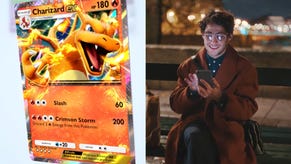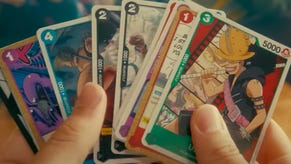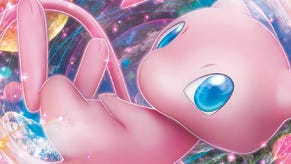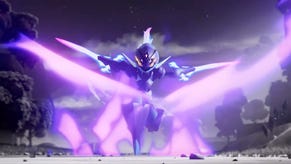How to play the Pokémon TCG: A beginner’s guide
Learn the basics of how to play the Pokémon TCG, card types and how evolutions work.
The Pokémon card game has gone from strength to strength since it span out of the popular pocket monster-collecting video games in the mid-nineties. While you might have plenty of Pokémon cards up in your attic, though, you might not remember the exact rules. No problem! Consider us your very own Professor Oak, as this beginner's guide will get you started with learning how to play the Pokémon Trading Card Game, from picking up the basic rules of attacking and status effects to getting to grips with how evolutions work.
How to play Pokémon TCG
- How many cards do you need to play Pokémon TCG?
- How to play the Pokémon Trading Card Game
- How does evolution work in the Pokémon TCG?
- How do status conditions work in the Pokémon TCG?
- How to win the Pokémon Trading Card Game
- Is there a Pokémon card game app?
Whether you’re a veteran Pokémon trainer who’s filled out their Pokédex in all of the video games since Red and Green or are taking your first steps into the world of Pokémon, there’s never been a better time to learn how to play the Pokémon TCG. Recent years have seen the introduction of exciting new gameplay elements inspired by the latest games, alongside the re-release of classic cards you might recognise from your childhood, meaning that longtime fans and complete newcomers alike can find their way into collecting and playing Pokémon cards in whatever way they prefer.
Part of what makes the Pokémon Trading Card Game so fun to play is the way it brings together everything from the series. Whether you enjoy evolving your Pokémon into powerful new forms, searching for shinies and rares, battling opponents, or just creating a party of all your favourite Pokémon, the card game lets you do that. With cards based on the video games, the animated TV series, movies and even unexpected inspirations such as famous artists, learning how to play the Pokémon TCG is a great way to dive even deeper into your love of everything Pokémon.
If you’re already a Pokéfan, then picking up the Pokémon TCG rules should come as second nature. While there are some new ideas in the card game, the basics are highly faithful to the battles in the video games - meaning that it feels just like wandering into tall grass and finding yourself head-to-head with an opponent! From status effects and super effective attacks to swapping out your Pokémon at the right time, everything you know and love about Pokémon is right here in the card game.
So read on to learn how to play the Pokémon card game and begin - or continue - your own journey into what might well become a lifelong hobby. Your very own Pokémon legend is about to unfold!
How many cards do you need to play Pokémon TCG?
Each player has a deck of exactly 60 cards, consisting of Pokémon cards, energy cards, item cards and trainer cards.
Apart from energy cards, you can’t have more than four cards in your deck with the same name.
When you're first learning how to play the Pokémon TCG, it might be best to pick up one of the pre-built decks available for the trading card game. Once you know the basics, you can learn how to build a Pokémon TCG deck to include all your favourite Pokémon and customise your play style.
How to play the Pokémon Trading Card Game
The basic flow of play in the Pokémon TCG is relatively simple to grasp, but it involves a few steps you’ll need to learn before your first battle.
How do you start the Pokémon TCG?
At the beginning of a game, players can flip a coin to see who plays first. Then the decks are shuffled, players draw a hand of seven cards and the top six cards are set aside as prize cards; you add one of these to your hand each time one you defeat an opponent’s Pokémon, and claim victory if you pick up all six before your rival.
Both players can place one basic Pokémon card facedown as their active Pokémon, plus up to five more basic Pokémon on their bench. If you don't have any basic Pokémon cards in your hand after drawing your initial hand of seven cards, reveal your hand to your opponent and draw seven more hands. You can repeat this as many times as you want until you have at least one basic Pokémon - but your opponent gets to draw one extra card for every time you do.
A player can have a total of six Pokémon in play at once, although only one - the active Pokémon - can perform attacks during each turn. The rest remain in your bench - a row of cards behind the active Pokémon where you hold five other Pokémon who wait to battle it out against your opponent, a bit like your party in the Pokémon video games. Both active Pokémon and benched Pokémon can be evolved and have energy attached to them. If your active Pokémon is defeated, you must replace it with one from your bench; if you have no Pokémon on the field at all, you lose.
How do turns work in the Pokémon TCG?
When each turn begins, the active player draws a card from the top of their deck; if you run out of cards in your deck and can't draw on your next turn, you lose.
During each turn’s second phase, you can do any and all of the following:
- Play any number of basic Pokémon from your hand to your bench.
- Attach one (and only one) energy card to a Pokémon from your hand. This can be your active Pokémon or a Pokémon on your bench.
- Evolve a Pokémon by playing a Stage 1 or Stage 2 evolution on top of a basic or Stage 1 Pokémon, respectively. A Pokémon can’t evolve the same turn it’s played, and can only evolve once per turn. (Unless an item card like Rare Candy specifies otherwise.)
- Play any number of item cards.
- Play any number of trainer cards. (Except supporter and stadium cards, which only let you play one per turn.)
- Retreat your active Pokémon to your bench by paying the retreat cost on its card in energy from your hand. You must then replace it with a Pokémon from your bench.
- Use any number of abilities on Pokémon cards.
Attacking in the Pokémon TCG
After you’ve done the above, your active Pokémon can attack the opponent. The Pokémon can perform one attack listed on its card as long as the correct amount and type of energy is attached to the card. (The energy isn’t discarded unless specified.)
Damage is assigned to the opponent’s active Pokémon as damage counters - once it receives as much damage as it has hit points, it faints. A defeated Pokémon must be replaced with a Pokémon from the bench (if there are no Pokémon to replace it, the player loses), and the player who knocked it out claims a prize card to add to their hand. If they claim their sixth and final prize card, they win.
Once you've attacked and assigned any damage and/or status effects, your turn ends and it's your opponent's go. The game repeats like this until one player wins!
How does evolution work in the Pokémon TCG?
The Pokémon Trading Card Game has a lot of similar traits to the Pokémon video games. One of the biggest similarities is that you can evolve your basic Pokémon to powerful Stage 1 and Stage 2 Pokémon, letting you use more powerful attacks and abilities to knock out your opponent’s Pokémon.
Evolution is done in stages, and you are unable to skip or jump any stages unless otherwise stated on a card in play - meaning evolution must follow the pattern of basic, Stage 1 and Stage 2, and a single Pokémon can only be evolved once per turn. (They also can’t be evolved the same turn they are played to your bench.) The exception are GX and EX Pokémon, which may be played straight away and do not require evolution.
To evolve a Pokémon, all you have to do is place the evolved form on top of your active Pokémon or a Pokémon on your bench. This cures any current special conditions, but any attached energy and damage stays put. Once a Pokémon has been evolved, you can’t use a previous stage’s attacks or abilities - only the current evolution.
Evolution can happen in the bench section of your play area, so you can make stronger Pokémon in preparation for your current one being knocked out - and it’s strongly recommended you do so.
How do status conditions work in the Pokémon TCG?
As in the Pokémon video games, the Pokémon Trading Card Game has a number of special conditions that can be inflicted on Pokémon, giving their opponent an extra advantage in a battle.
The special conditions are Asleep, Burned, Confused, Paralyzed and Poisoned, and are indicated by turning the Pokémon card counterclockwise (Asleep), upside-down (Confused) or clockwise (Paralyzed), or putting a special token on it (Burned or Poisoned). Multiple special conditions can affect the same Pokémon - in the case of effects indicated by turning the card, the most recent condition is the only one applied.
Asleep
If a Pokémon is asleep, it can’t attack or retreat. The card is rotated 90 degrees counerclockwise to show its status condition. At the end of their turn, the player flips a coin - on a head, the Pokémon wakes up and is no longer asleep.
Paralyzed
When a Pokémon is paralyzed, it can't attack or retreat on the player's next turn. The card is rotated 90 degrees clockwise to show its status condition. At the end of the player's next turn, paralyzed is automatically cured.
Burned
The Pokémon card receives a burned token to show its status condition. A burned Pokémon receives two damage counters (20 HP) at the end of each turn. After suffering this damage, the player flips a coin. On a heads, Burned is cured.
Confused
Pokémon video game players will be oh-so-familiar with the words “It hurt itself in its confusion!” Confusion in the Pokémon TCG works the same - when you attack with a confused Pokémon, flip a coin. On heads, the attack happens as normal. On tails, the attack fails and the Pokémon suffers three damage counters (30 HP). The Pokémon card is rotated 180 degrees (making it upside-down) to show its status condition.
Poisoned
A poisoned Pokémon suffers one damage counter (10 HP) at the end of each turn.
Special conditions can also be cured by evolving a Pokémon or retreating it to the bench, which cures all special conditions. (Remember that asleep and paralyzed Pokémon can’t retreat!)
How to win the Pokémon Trading Card Game
Like many other competitive trading card games, the Pokémon TCG can be won in a variety of ways:
- The most common path to victory is to knock out six of your opponent’s Pokémon and collect prize cards. Every time you defeat a Pokémon controlled by your rival, you claim one of the six prize cards you set aside at the start of the game and add it to your hand. When you pick up your sixth and final card, you win!
- If you defeat an opponent’s active Pokémon and they have no available Pokémon on their bench to replace it, you can also claim victory.
- If your opponent runs out of cards in their deck, and therefore can’t draw a card at the beginning of their turn, you win. This is what’s known as ‘decking’ your opponent.
Is there a Pokémon card game app?
As well as the physical Pokémon Trading Card Game, you can play the Pokémon card game digitally using the Pokémon TCG Live app. Pokémon TCG Live is a free-to-play app available for PC and mobile devices on iOS and Android that lets you play the Pokémon Trading Card Game against AI opponents or friends.
A tutorial mode makes the Pokémon card game app a good way to learn how to play the Pokémon TCG, while the app's deck builder can make figuring out how to build a Pokémon TCG deck with your cards easy.








